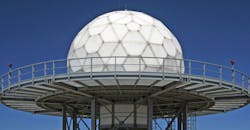Satellite missions devoted to Earth observation (EO) have often involved polar orbits, along with the need to ground station terminals located in Arctic or Antarctic polar regions. But those ground station terminals must be protected from this planet’s most severe environmental conditions when they are constructed in the polar regions. Especially as these satellite missions reach higher frequencies, such as K-band frequencies (25.5 to 27.0 GHz), the radomes must provide a combination of solid mechanical protection and reliable electromagnetic (EM) performance at the higher frequencies. The quest for radome materials for the latest EO satellite missions has involved detailed weather analysis to find the best compromise between mechanical and EM performance for these polar radomes.
The environmental conditions at polar latitudes are complex and extreme, making the evaluation of radome materials for polar earth stations quite difficult. Three factors, in particular, come into play when evaluating radome materials: the wind speed, the air temperature, and the amount of snow precipitation. A suitable test location for evaluating radome materials and the impact of these three factors was chosen in the Svalbard archipelago in the Arctic Ocean, at an approximate latitude of 78ºN. In support of the material experiments under these extreme weather conditions, details on the weather were provided by several weather stations, including the University Center in Svalbard, the Norwegian Meteorological Institute, and the Kongsberg Satellite Services (KSAT).
While details on some of the radomes that were studied remained proprietary to the companies providing the radomes, a great deal was learned by comparing different mechanical radome structures under these severe weather conditions. Constant high wind speeds, for example, can result in permanent deformation of a radome and require spare parts when a radome is expected to survive such extreme weather conditions.
The researchers used EM simulation software to better understand the impact of wind and precipitation on the EM transparency of different radome materials and mechanical designs, including how different types of membranes and panels are used in the design and construction of a radome. For satellite Earth stations located at the polar ice caps, this study certainly offers a great deal of insight into the importance of a radome configuration and the selection of its material content.
See “High-Frequency Radomes for Polar Region Ground Stations,” IEEE Antennas & Propagation Magazine, Vol 59, No. 6, December, 2017, p. 88.
About the Author
Jack Browne
Technical Contributor
Jack Browne, Technical Contributor, has worked in technical publishing for over 30 years. He managed the content and production of three technical journals while at the American Institute of Physics, including Medical Physics and the Journal of Vacuum Science & Technology. He has been a Publisher and Editor for Penton Media, started the firm’s Wireless Symposium & Exhibition trade show in 1993, and currently serves as Technical Contributor for that company's Microwaves & RF magazine. Browne, who holds a BS in Mathematics from City College of New York and BA degrees in English and Philosophy from Fordham University, is a member of the IEEE.

